Ambulthiyal(Sri Lankan sour fish curry).
Ambulthiyal, also known as malu ambulthiyal, is a must-try Sri Lankan sour fish curry.
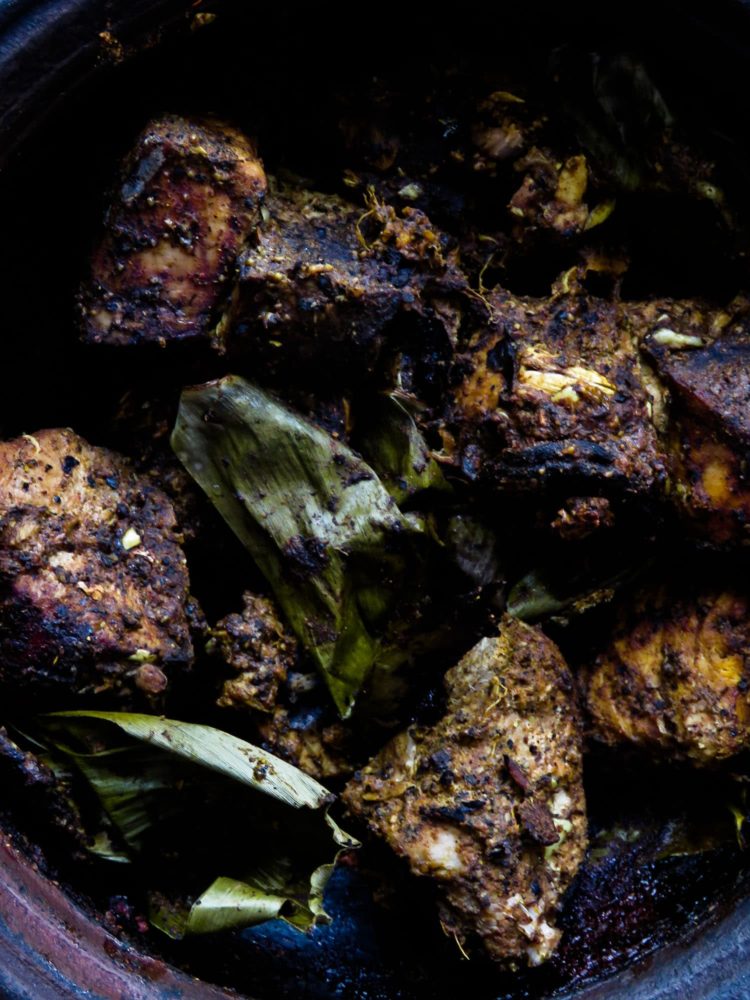
Made with Goraka(dried garcinia) and black pepper, not only gives the fish ambulthiyal(sour fish)curry a unique taste but is also a method of preserving fish without refrigeration or freezing.
What does”Ambulthiyal”mean?
Ambulthiyal is the Sinhalese word for a very distinct fish curry.
It’s cooked using a spice blend that turns the outer part of the fish black in colour.
“Ambul” actually means sour, hence the name”sour fish”.
What is”goraka”?
It’s also known as Brindleberry, Indian tamarind and in Sinhalese,”goraka“. These are the ingredients that give the fish curry a sour taste.
You can substitute “goraka” with tamarind paste, but you need to be careful with the tamarind as it has a sharper sour taste than “goraka”, which in turn might make the fish too sour.
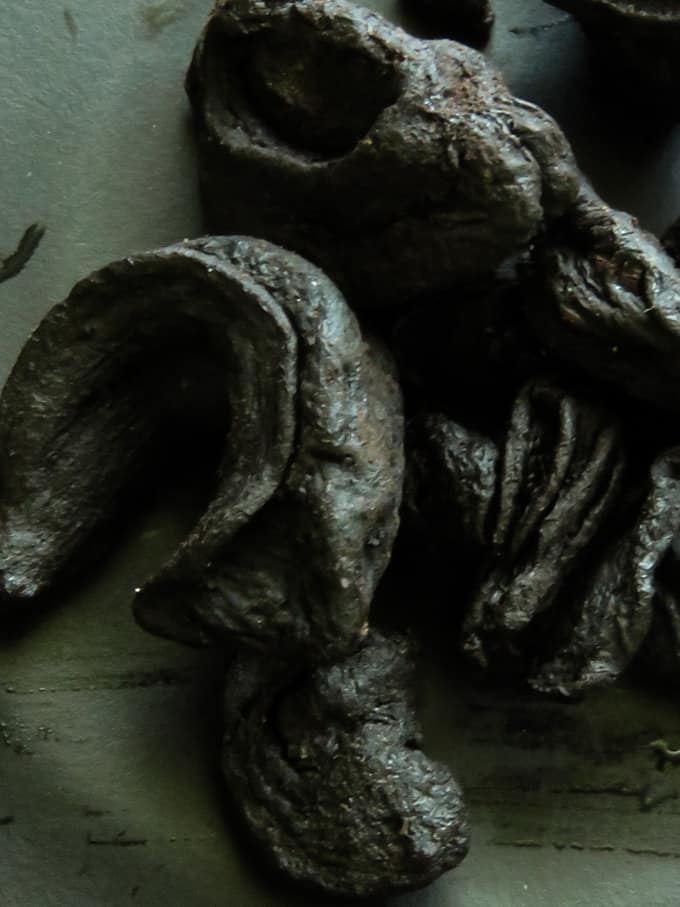
What to serve with ambul thiyal(sour fish curry).
- Main dishes to serve with malu ambulthiyal.
- Serve with plain white rice, Sri Lankan yellow rice, or even ghee rice.
- If you are serving with coconut roti(pol roti), naan, no yeast naan or poori, make sure you have a dhal or potato curry, as this sour fish is a completely dry curry.
- Vegetarian curries and salads you can pair with malu ambulthiyal.
You can also add some fried poppadams and fried curd chillies. For more options, use the search bar to come up with more dishes to pair with ambulthiyal.
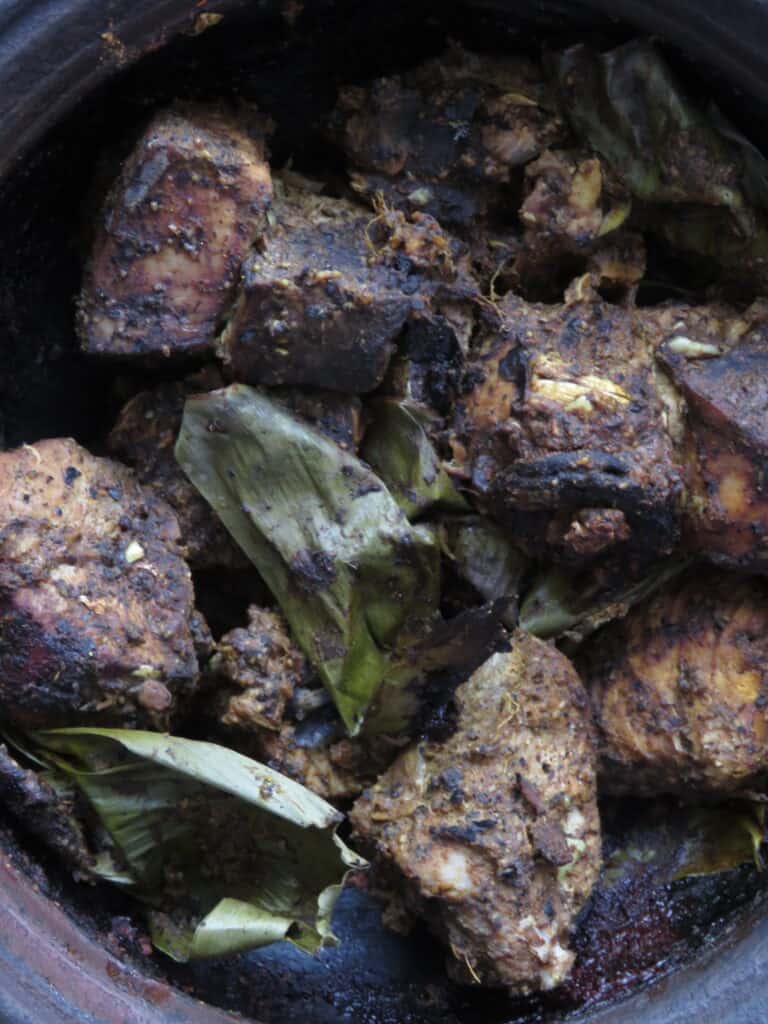
Tips and questions on ambulthiyal fish curry.
- Types of fish to make the sour fish.
- Any type of firm fish would do.
- kelewella(yellowfin tuna).
- Balaya(skipjack tuna).
- Talapath(sailfish).
- I’m using yellowfin tuna.
- Any type of firm fish would do.
- First, a large clay pot that won’t crowd the fish, so that when you have to move them a bit, you don’t end up breaking the fish into smaller pieces.
- Do I need banana leaves to make fish ambulthiyal?
- There’s a reason why some foods are cooked, eaten or wrapped in banana leaves.
- One reason is that it adds a subtle flavour and fragrance to the dish.
- When it comes to Fish Ambulthiyal, it prevents the fish from charring too much, although a bit of charring does add flavour to it.
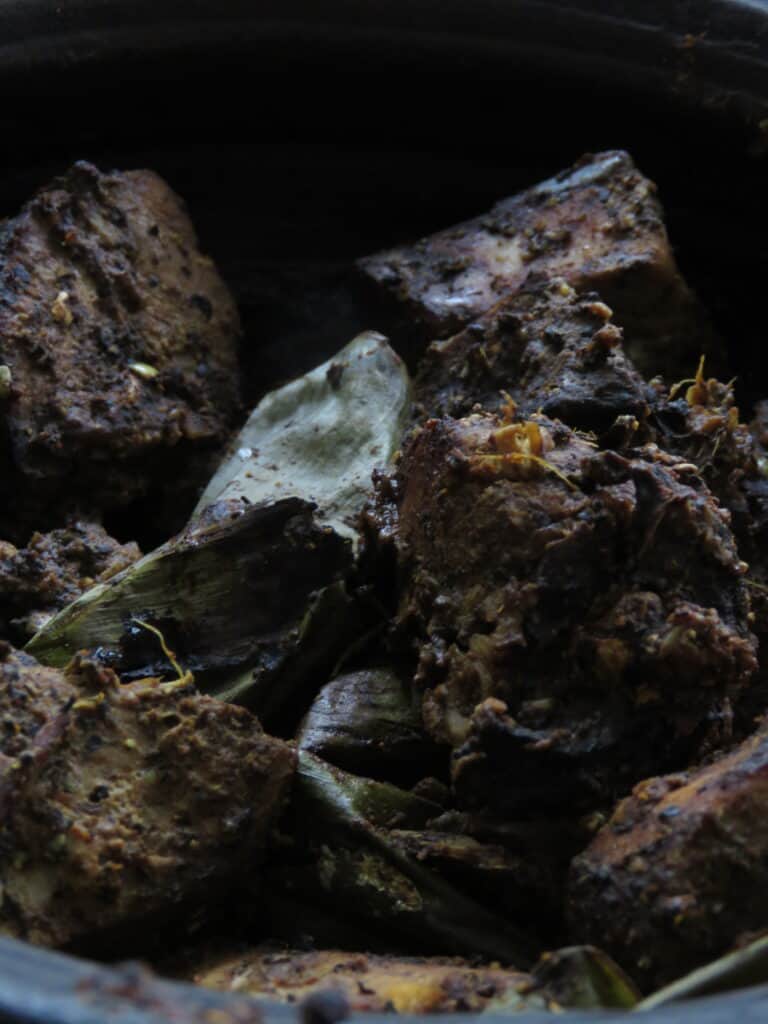
Workflow to make the abulthiyal fish curry.
- Have all the ingredients and the pan needed to make the Malu ambulthiyal.
- Make the goraka paste.
- Make the spice paste and combine both.
- Combine both pastes with other seasonings.
- Place the banana leaves inside the cooking clay pot.
- Cook as directed in the recipe.
More fish curry recipes.
- Sri Lankan red chilli fish curry(thalapath malu mirisata).
- How to make Sri Lankan canned fish curry.
- deviled fish(Sri Lankan, spicy chili fish stir-fry)
- Canned tuna fish stir-fry(devilled).
- Sri Lankan Fish curry with coconut milk(thalapath fish curry).
Storage, freezing and reheating guide.
Storage.
This is the perfect dish to take with you to your relatives overseas. This method of cooking the fish preserves it well.
Packed well, the sour fish can be taken with you on long-distance travel.
Make sure to pack in a tight-lid box and store in zip-lock bags to avoid any type of fish smell spreading onto your personal items.
Freezing.
Packed in an airtight container. You can freeze the sour fish for 3-4 weeks.
Stop food waste by.
Any leftover fish can be frozen or refrigerated ONLY if the sour fish was handled carefully with spoons to serve.
RECIPE DIFFICULTY- MORE CARE IS NEEDED
Ingredients to cook fish ambulthiyal.
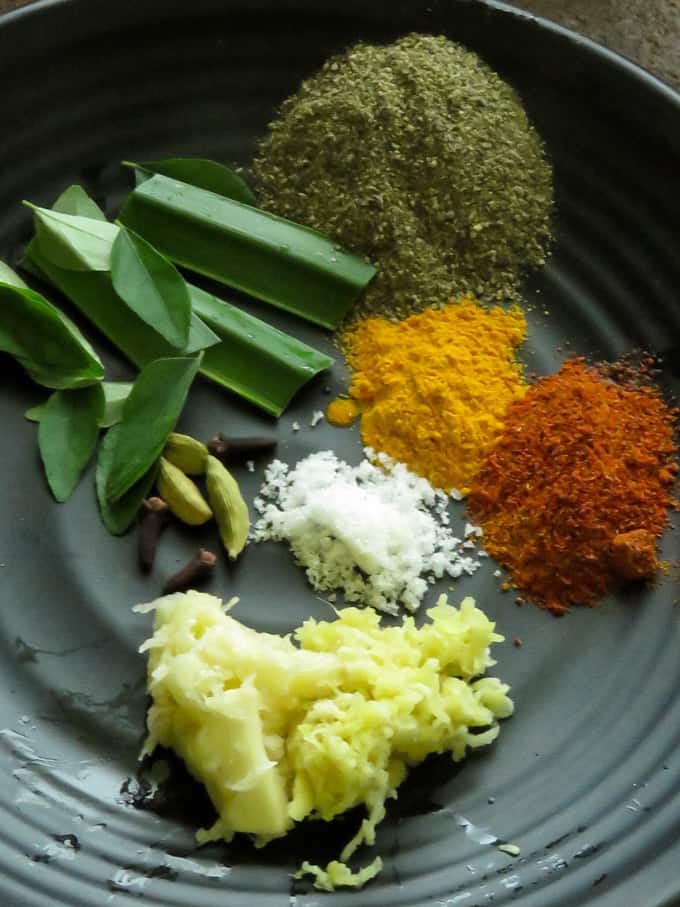
- Firm fish(kelewella, balaya,talapath would be ideal, see notes above).
- Goraka, soaked for 5 minutes and then pounded to form a fine paste.
- Black pepper.
- Minced/grated ginger.
- Garlic cloves minced/grated.
- Cardamom pods slightly bruised
- Pandan leaves
- A sprig of curry leaves
- Cloves
- Red chilli powder
- Turmeric powder
- Salt to season
- Water as needed(just enough to cover the fish)
Step-by-step photo tutorial.
How to cook Ambulthiyal(Sri Lankan sour fish).
Have all the ingredients needed to make sour fish(Ambulthiyal) ready.
Cut the fish into the required size, so that they fit the pan while not crowding within the pan.
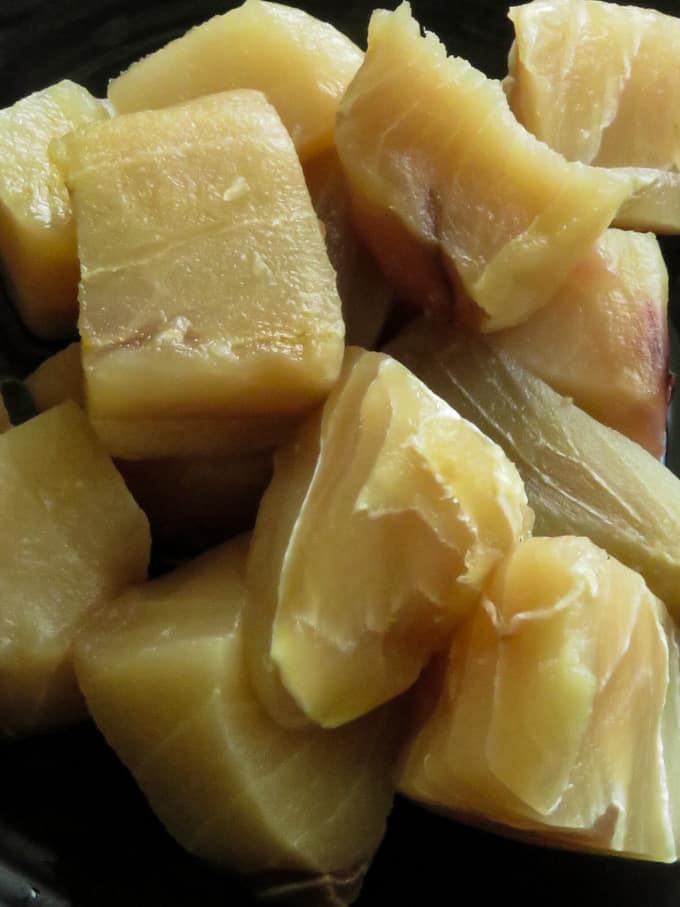
Preparing the ambulthiyal paste.
Soak the goraka pieces for 5 minutes and then grind them into a fine paste. You will need a little water to make the grinding process easier.
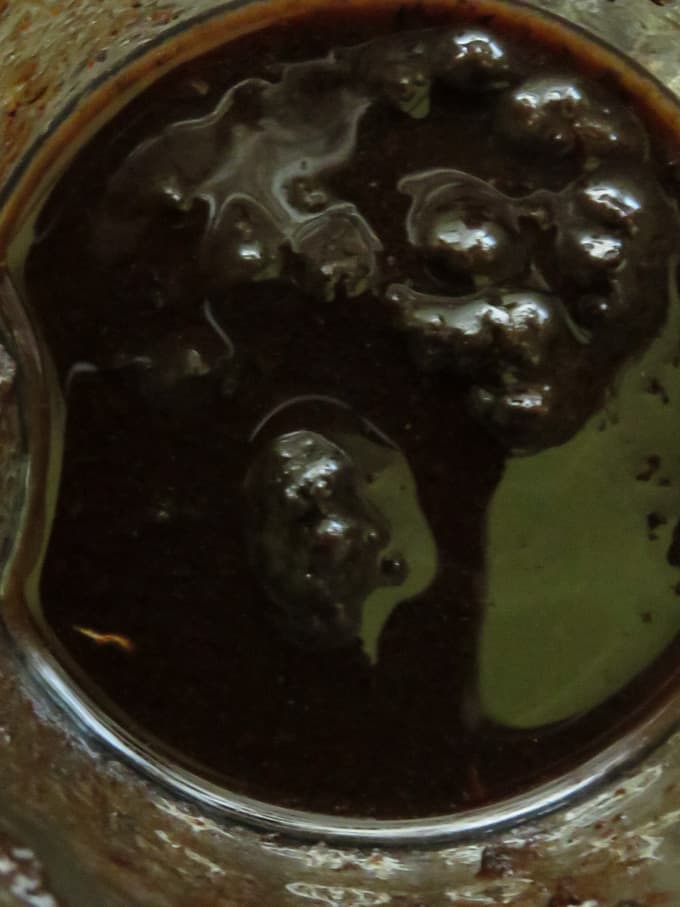
Grind and make a paste using garlic cloves, ginger, pepper, cloves, curry leaves, pandan leaves, cardamom, red chilli powder, and turmeric powder.

Once you have a fine paste of goraka as well as the other ingredients mentioned above.
Combine both pastes, check for seasoning, and add salt and more pepper if necessary.
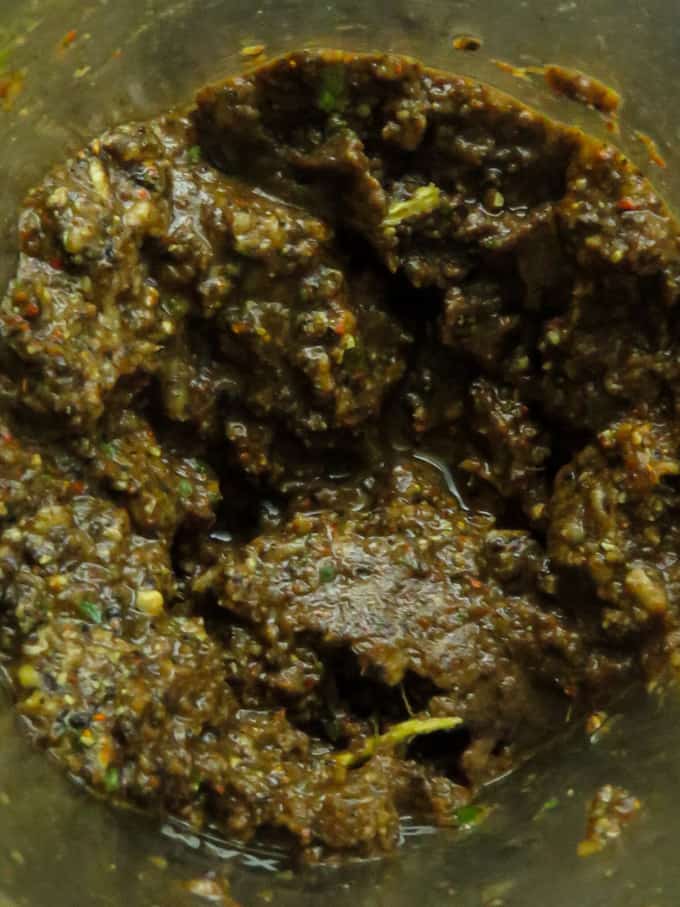
Cooking the Sri Lankan ambulthiyal fish curry.
Add the spice paste to a large bowl with the fish pieces and mix well.
I would recommend wearing disposable gloves if possible, since your hands and nails will carry the smell of the spices for a few hours.
Set aside for 10-15 minutes while you prepare the clay pot to cook the fish.
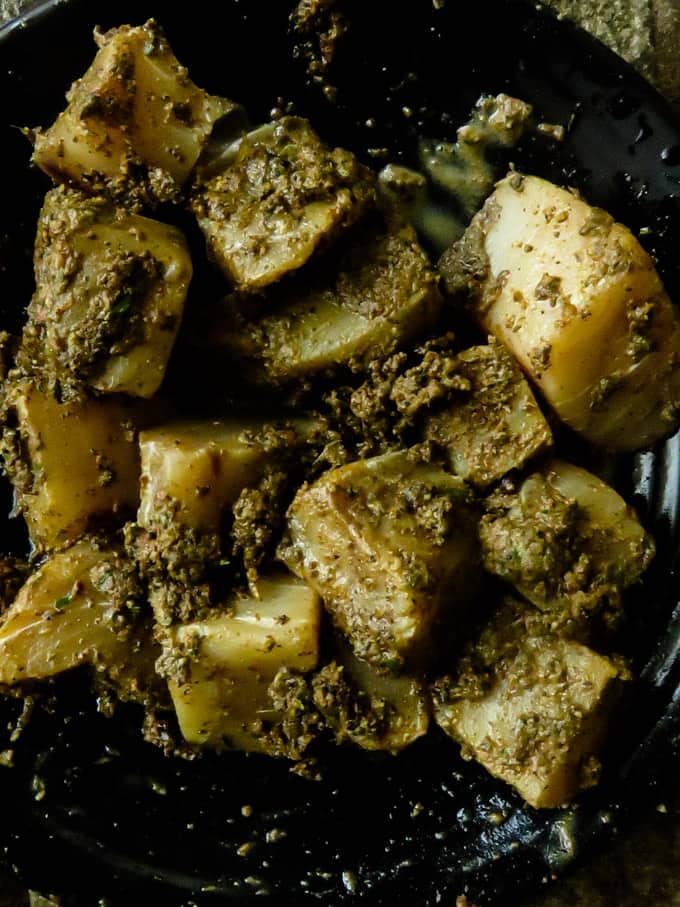
Cut the banana leaf in a way you can layer the bottom of the clay pot, either in rectangular pieces or one in the shape of a disk.
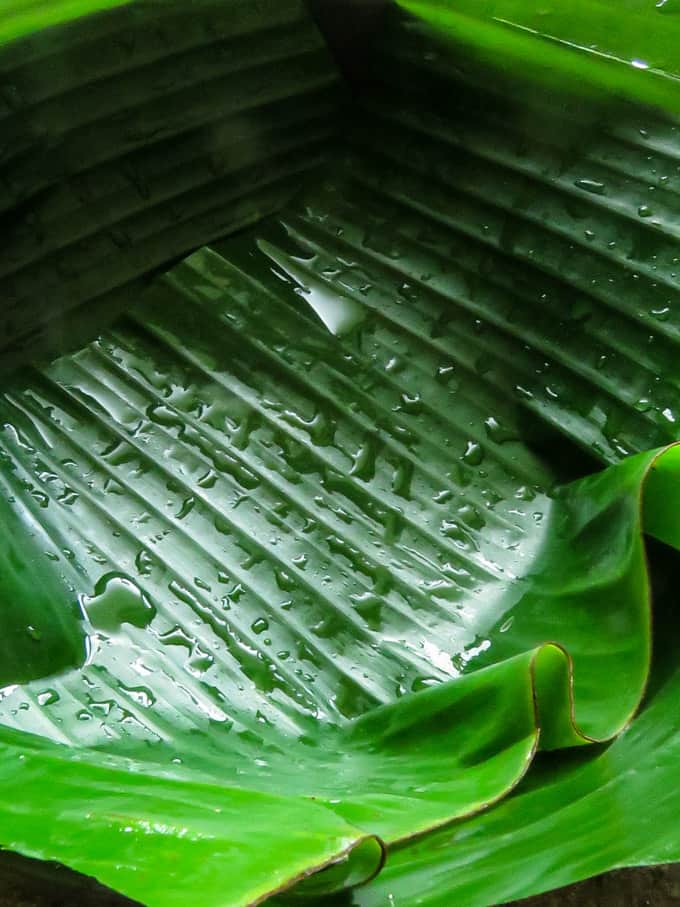
Once you place the banana leaf at the bottom of the pan, give the fish a last mix and add them to the clay pot.
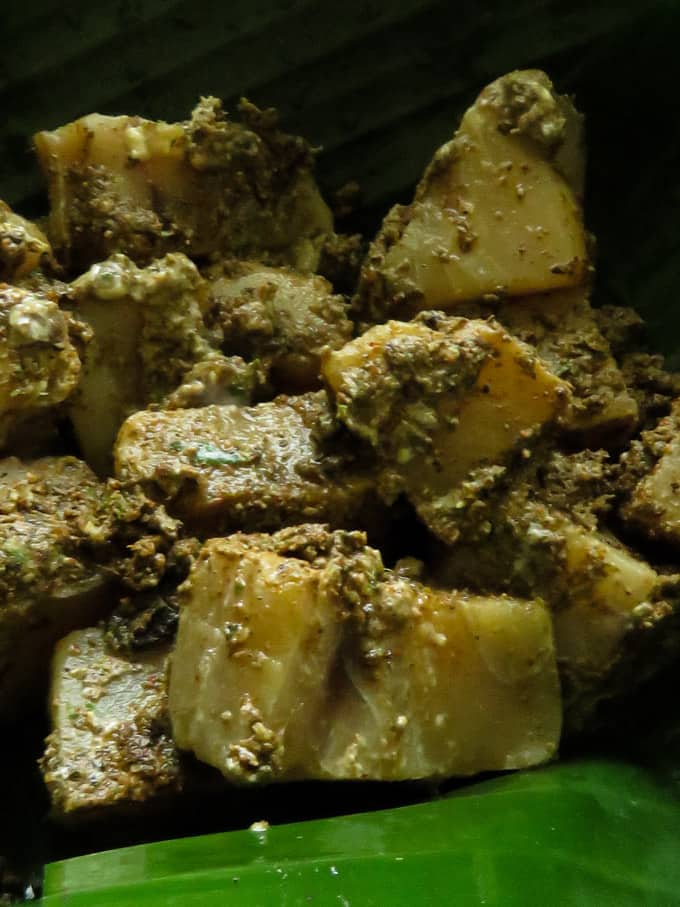
Try not to crowd the fish or stack them one over the other too much, as you want all the pieces of fish to cook evenly and intact.
If there is leftover marinade in the bowl, add 1 cup of water to it, collect the marinade and pour the water over the fish.
Check if the water just about covers the fish; if not, add more.
Place the pan over a low fire, and let it simmer until the water evaporates completely.
Do not mix or use a spoon on the dish at any point in the cooking process.
If you really want to move the pieces, hold the pan from both sides and give a little shake for the fish to settle.
Once the fish takes on a blackish tinge while slightly charring on the bottom, remove it from the fire and let it cool.
Then gently pry the fish pieces so they come off the pan easily.
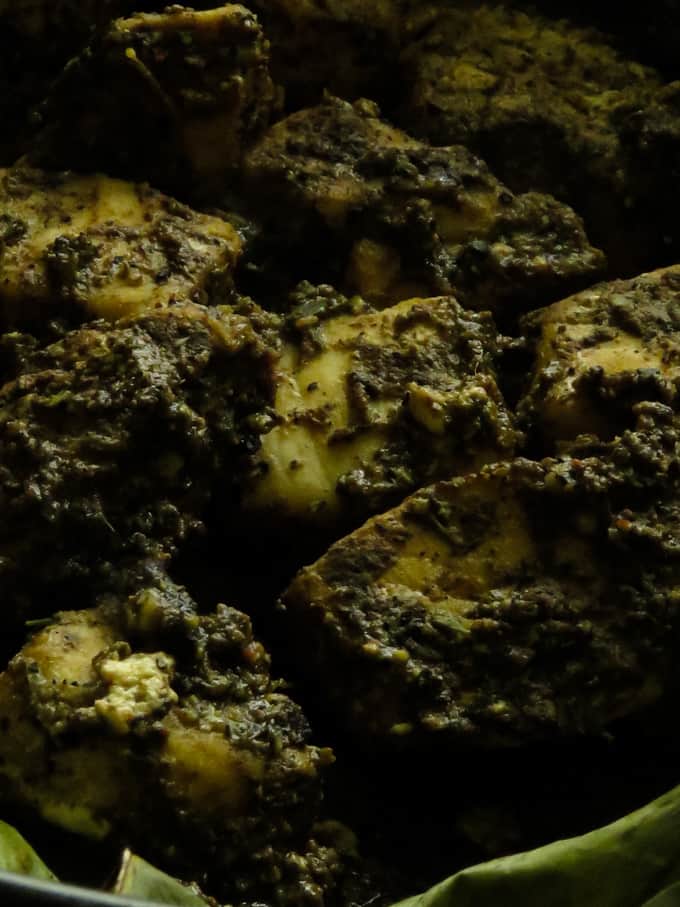
JOIN ME ON ISLANDSMILE YOUTUBE CHANNEL

Sri Lankan ambulthiyal(sour fish curry).
A must-try Sri Lankan fish curry.
Made with goraka and black pepper, not only gives the fish ambulthiyal curry a unique taste but is also a method of preserving it.
Ingredients
- Ingredients mentioned below use standard measuring cups and spoons.
- 500g of firm fish(kelewella, balaya,talapath would be ideal, see notes above)
- 5 pieces of goraka soaked for 5 minutes and then pounded to form a fine paste.
- 3 tablespoons of good quality black pepper
- 1 tablespoon of minced/grated ginger
- 4 garlic cloves minced/grated
- 3 cardamom pods slightly bruised
- 2-inch pandan leaves
- Sprig of curry leaves(5-8 leaves)
- 3 cloves
- 1 teaspoon chilli powder
- 1/4 teaspoon turmeric powder
- Salt to season
Instructions
- Have all the ingredients for the sour fish(ambul thiyal)curry.
- Cut the fish into the required size, they should fit the pan while not crowding within the pan.
- Soak the goraka(5) pieces for 5 minutes and then grind them into a fine paste.
- You will need a little water to make the grinding process easier.
- Grind and make a paste using garlic(4 cloves), ginger(1tbs), pepper(3tbs), cloves(3), curry leaves(a sprig), pandan leaves(2inch), cardamom(3), red chilli powder(1tsp), turmeric(1/4tsp).
- Once you have a fine paste of goraka as well as the other ingredients mentioned above,
- Combine both the pastes, check for seasoning, and add salt and more pepper if necessary.
How to cook ambul thiyal.
- Add the paste to a large bowl with the fish pieces and mix well, set aside for 10-15 minutes while you prepare the clay pot to cook the fish.
- Cut the banana leaf in a way you can layer the bottom of the clay pot, either in rectangular pieces or one in the shape of a disk.
- Once you place the banana leaf in the bottom of the pan, give the fish a last mix and add them to the clay pot.
- Try not to crowd the fish or stacking them one over the other too much as you want all the pieces of fish to cook evenly and intact.
- If there is leftover marinade in the bowl, add 1 cup of water to it, collect the marinade and pour the water over the fish.
- Check if the water just about covers the fish, if not add a little more.
- Place the pan over a low fire, and let it simmer until the water evaporates completely.
- Do not mix or use a spoon on the dish at any point in the cooking process, if you really want to move the pieces, hold the pan from both sides and give a little shake for the fish to settle.
- Once the fish takes on a blackish tinge while slightly charring on the bottom, remove it from the fire and let it cool. then gently pry the fish pieces so they come off the pan easily.
Recommended Products
As an Amazon Associate and member of other affiliate programs, I earn from qualifying purchases.
-
 OXO Good Grips Soft- Handled Garlic Press
OXO Good Grips Soft- Handled Garlic Press -
 OXO Good Grips Wooden Spoon Set, 3-Piece
OXO Good Grips Wooden Spoon Set, 3-Piece -
 Spice Container - Masala Dabba - 7 Compartments, masala box,steel masala dabba,Spice container box,stainless steel spice box indian masala dabba with 7 spice containers with size 8 X 8 inches (1)
Spice Container - Masala Dabba - 7 Compartments, masala box,steel masala dabba,Spice container box,stainless steel spice box indian masala dabba with 7 spice containers with size 8 X 8 inches (1) -
 Kitchen Shears by Gidli - Lifetime Replacement Warranty- Includes Seafood Scissors As a Bonus - Heavy Duty Stainless Steel Multipurpose Ultra Sharp Utility Scissors
Kitchen Shears by Gidli - Lifetime Replacement Warranty- Includes Seafood Scissors As a Bonus - Heavy Duty Stainless Steel Multipurpose Ultra Sharp Utility Scissors -
 Bamboo Cutting Board Set with Juice Groove (3 Pieces) - Wood Cutting Boards for Kitchen, Wood Cutting Board Set, Kitchen Chopping Board for Meat (Butcher Block) Cheese and Vegetables
Bamboo Cutting Board Set with Juice Groove (3 Pieces) - Wood Cutting Boards for Kitchen, Wood Cutting Board Set, Kitchen Chopping Board for Meat (Butcher Block) Cheese and Vegetables -
 Secura 60-Minute Visual Timer, Classroom Countdown Clock, Silent Timer for Kids and Adults, Time Management Tool for Teaching (Black)
Secura 60-Minute Visual Timer, Classroom Countdown Clock, Silent Timer for Kids and Adults, Time Management Tool for Teaching (Black) -
 Fullstar Vegetable Chopper - Spiralizer Vegetable Slicer - Onion Chopper with Container - Pro Food Chopper - Black Slicer Dicer Cutter - 4 Blades
Fullstar Vegetable Chopper - Spiralizer Vegetable Slicer - Onion Chopper with Container - Pro Food Chopper - Black Slicer Dicer Cutter - 4 Blades -
 Kitchen Shears, iBayam Kitchen Scissors Heavy Duty Meat Scissors Poultry Shears, Dishwasher Safe Food Cooking Scissors All Purpose Stainless Steel Utility Scissors, 2-Pack (Black Red, Black Gray)
Kitchen Shears, iBayam Kitchen Scissors Heavy Duty Meat Scissors Poultry Shears, Dishwasher Safe Food Cooking Scissors All Purpose Stainless Steel Utility Scissors, 2-Pack (Black Red, Black Gray) -
 OXO Good Grips Swivel Peeler
OXO Good Grips Swivel Peeler -
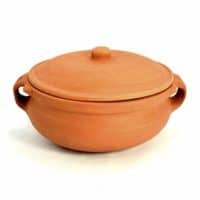 Ancient Cookware Clay Curry Pot, Medium, 8 Inch
Ancient Cookware Clay Curry Pot, Medium, 8 Inch -
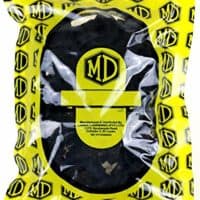 MD Goraka Pieces 200g
MD Goraka Pieces 200g
Nutrition Information:
Yield: 5 Serving Size: 1Amount Per Serving: Calories: 142Total Fat: 3gSaturated Fat: 1gTrans Fat: 0gUnsaturated Fat: 2gCholesterol: 57mgSodium: 192mgCarbohydrates: 3gFiber: 1gSugar: 0gProtein: 27g
Nutrition facts are an estimate and not guaranteed to be accurate. Please see a registered dietitian for special diet advice.
With you in mind, each recipe on this blog has been written with great care and love to the best of my ability.
It’s free and on the blog, so you can try it anytime.
Please do not save it on apps, recipe boxes, or online groups, as this will affect me as a food blogger and the growth of this blog.
I would appreciate it if you could share the link rather than the full recipe.
All images and text on this website are protected by copyright.
Samantha
Wednesday 4th of October 2023
Hi, is there a substitute for the banana leaf? Will placing the fish directly in the clay pot make it stick to the bottom? TIA
jehan
Wednesday 4th of October 2023
Hi Samantha. I think it would as you cook the fish till it becomes a dry curry and since the spices are heavy in this dish it is the first thing that will stick to the pot. especially the clay pot. Here are my suggestions, cook it on a non stick pan if you are unable to find banana leaf or cook in a clay pot but try to minimize the sticking and burning by using very little heat at the end and removing the ambulthiyal curry a little early, and letting the remaining heat cook the fish dry. Hope this helps, J
Davina de Fonseka
Tuesday 13th of July 2021
how much tamarind should we substitute instead of the goraka?
jehan
Tuesday 13th of July 2021
Hi Davinda, For 500g, 3 tablespoons of thick tamarind paste should do but please do check the concentration of the tamarind paste. Depending on the brand, I've noticed some tamarind paste tends to be thin than others. If the tamarind paste is thin then add an extra tablespoon(makes 4 tbsp). Make the Ambulthiyal paste, taste and add more paste as needed, you'll want it to be really sour. I'll make a note to use tamarind next time I make the fish curry and will add notes on it when time permits. Hope this helps, Regards J
Thisura
Saturday 17th of April 2021
Prepared this for the Sinhala Tamil New Year. Used Spanish mackerel instead of tuna. And marinated it for 30 minutes. Had to simmer it for a bit longer as it is a softer fish. But other than that made no changes to the recipe. The salt/sour balance was on point. Everyone loved it! Thanks a lot for a quick and easy recipe.
jehan
Sunday 18th of April 2021
Hi Thisura, thank you for trying out the recipe and so glad it came out well. will recommend the type of fish mentioned here to my other readers. please rate the recipe if possible as this helps me to grow and others to find the recipe easily on google. Stay safe and regards, J
Karen
Saturday 15th of August 2020
Thanks for sharing this recipe! We love fish and I love a good sour curry so I'm very excited to try this out. May I know if you cook the fish covered or uncovered?
jehan
Saturday 15th of August 2020
Hi Karen, You are most welcome. You can cook the fish half-covered at the initial stage and then uncovered at the very end just to keep an eye on the fish curry. will mention this on the recipe post for other readers as well. Regards. J
Kaya
Sunday 21st of June 2020
I am a tamil and a novice to Sinhala cooking. Husband loves Ambulthiyal and I have tried various recipes and this was the one I nailed! I am becoming a frequent visitor to your site thanks for your efforts
jehan
Monday 22nd of June 2020
Hi Kaya, Thank you for letting me know the recipe worked for you, I wish I could add some real Tamil Sri Lankan recipes, will try to add when I have a few. appreciate you visiting my site frequently and helping the site grow. regards, Jehan